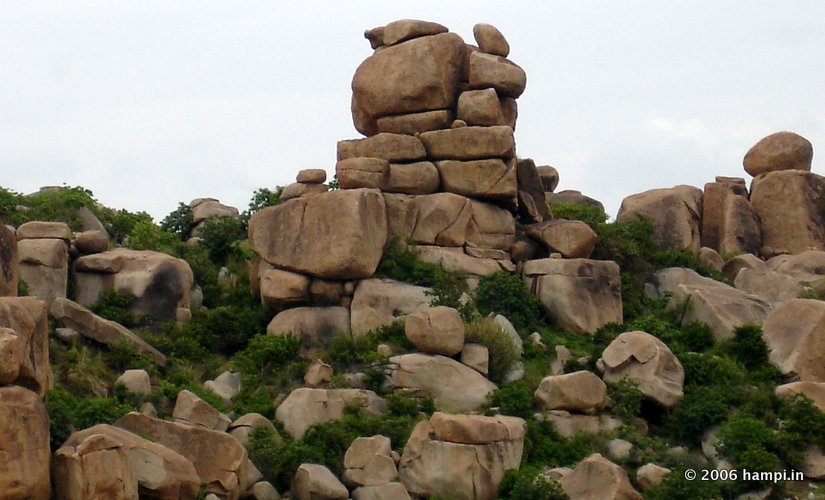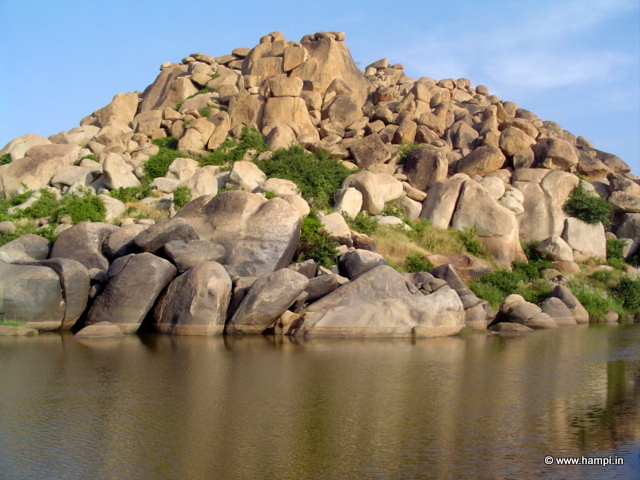Origin of Hampi’s Boulders
Those finally end up in Hampi invariably wonder how on earth such a landscape got created! Well, you have two choices to find a solace: one in geology and the other in mythology!

The Geologist's version first: The Hampi’s boulder strewn landscape is one of the oldest exposed surfaces on earth. Unlike most of the mountain ranges, the boulder heaps of Hampi were not formed as a result of volcanisms or of any uplift in the earth’s crust. The boulders were once part of gigantic granite monoliths (massive mountain of rock).
T
ens of millions (some even put it as a few billions) of years of erosion thanks to the natural forces (sun, storm, wind etc) made the surface of the monoliths crack, split and eventually metamorphed in to its present forms. The pieces that lost balance in the process crumbled and formed the boulder heaps. The ones managed to balance somehow remained in some quasi-stable state, puzzling the spectators.Children (and also curious among grownups) who visit Hampi often ask, How did they manage to stack up such giant boulders one over the other!? The answer is simple. Nature played the role of a sculpturer. It scooped out the ‘unwanted’ portion out of those giant granite monoliths, making it look as if someone had stacked the boulders with precision.
Hindu mythology has a different story to say. This is far more dramatic than the geology version, and it gels well with the rest of Hampi’s mysteries than the so-called erosion theory.
Hampi is believed to be the erstwhile mythical monkey kingdom. And there was a bitter power struggle going on between the princely brothers, Sugreeva and Vali. In a pitched battle Vali defeats Sugreeva and chases him out of the kingdom. The frightened Sugreeva took refuge at the Matanga hill (the tallest hill in Hampi ) as Vali can’t climb it thanks to an earlier curse on him.
Rama , the king of Ayodhiya , reaches Kishkinda in search for his abducted wife, Sita. Hanuman, the monkey general finds Sita in Lanka (Sri Lanka) in custody of the demon king Ravana. Vali offers help of his monkey army to attack Lanka and free Sita. In return Rama helps him to kill Sugreeva and regain the throne of the monkey kingdom.
The battle between Vali and Sugreeva was so intense that the boulders threw at each other piled up all around Hampi. In another version of the story, the monkey army piled up the boulders here to build a bridge to Lanka. That helped the monkey army to march to Lanka.
Rishikukh Hill, a popular spot among the boulderers as ‘Hampi Island’ is believed to be the place where Hanuman first met Rama and his brother Lakshmana.
According to the myths the place south of Rishimukh (across the river) is the place where Rama crowned Sugreeva, after killing Vali. A temple called Kodanda Rama Temple stands at this place.
The Anjaneya Hill, with the characteristic whitewashed zigzag stairs to the hilltop is believed to be the birthplace of Hanuman.
In short, Hampi – in mythological terms- has been a happening place. And that explains why there are so many temples built in Hampi. You’ll find endless mythical themes (Mythology of Hampi) carved all over the Hampi. Of all, the Hanuman icons definitely steal the show.
It is only logical if some boulderers (see Bouldering in Hampi) consider Hanuman as their presiding deity! After all Hanuman is a symbol of defiance and strength, the very essence of any boulderer.

Tungabhada River makes a bend around the boulder strewn Rishimukh Hill
Tungabhada River makes a bend around the boulder strewn Rishimukh Hill

A balancing boulder atop Malayavanta Hill
A balancing boulder atop Malayavanta Hill
